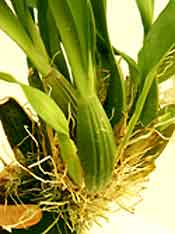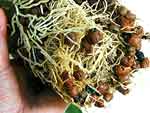

Orchid Care - Oncidium
 Bllra.
Howards Dream
|  Wilsonara Kolibri
|  Onc. Gower Ramsey |
 Onc. Sharry Baby |
| Oncidium is a large, diverse group of plants that includes over 600 species! The flower displays in this group are among the most dramatic in the orchid world. Colors range from bright yellow to bronze, white with pink, and glittering shades of dark red. Some have hundreds of blooms on flower spikes over 4ft long! | ||
| Early exlporers were spellbound by fields golden yellow, doll-like flowers moving gracefully in the wind. So the fiirst Oncidiums were called "The Dancing Lady", as symbol of the beautiful, exotic dancers of Ceylon ( Sri Lanka). |
|
|
Because Oncidiums grow in many different habitats, they seem to be more accomodating in their growing requirements than most orchids. Most are excellent plants for "northern" growers whose temperatures are cooler during winter months. |
||
| Water Oncidiums don't like wet feetIn their natural habitat Oncidiums are epiphytic (air plants) that grow on rocks or in trees - never in the ground. That's why you'll often see active roots growing above the pot (see photo). Nature has also equiped Oncidiums with a "storage tank" at the base of each growth called a pseudobulb. These pseudobulbs provide water to the plant during long dry periods between rain showers. To prevent overwatering, Oncidium are usually planted in a coarse, fast draining media. This can make correct watering a challenge. As the water quickly runs through the pot, how can you be sure the plant is getting anything? Soaking the root system at the sink or in a bucket of water is the only way. This is time consuming when you have more than a couple of plants. And if you water too often, the roots will rot quickly. Watering Oncidium with our system is easy! Our Hydroponic Grow System has a water gauge that makes watering easy. Simply water to 1/4 - 1/2 on the gauge, then wait for the system to dry out completely before rewatering. The "wicking action" of the LECA pebbles delivers the nutrient solution from the resevior at the bottom of the pot gently and evenly. Because the LECA pebbles won't decay or pack down, the roots will get plenty of air. Good air circulation at the roots is important for Oncidiums. Just make sure the system is completely dry before rewatering (usually takes about 2 weeks) and you'll never have to worry about overwatering. |  Pseudobilbs on Oncidium
with active roots growing
in the air |
|
| Light With orchids, we always say "there's a place to grow them and there's a place to show them". This is particularly true for Oncidium. During the growing season, these plants need several hours of direct sun every day to build up the energy to flower. Then, when the flowering cycle arrives (hurray!) and the first couple of flowers open, move the plant away from the direct sun to encourage longer lasting flowers. Hot sun deteriorates Oncidium flowers quickly. After the blooms have faded, cut back the flower spike and move the plant back to a sunny spot to begin the next growth cycle. | ||
Temperature We recommend cool night time temperatures in the 50-60 degree range. With good air circulation temps can reach 90 during the day. Remember, cool nights (along with good light during the day) initiates flower spikes. Cool daytime temperatues also prolongs the life of the flowers. | ||
| Why
Hydroponics? Correct watering for these plants can be tricky. Coarse, fast draining potting material is necessary because Oncidium's thin roots decay quickly with too much water. They love our LECA pebbles because they never compact, decay, or breakdown. This promotes good drainage and maxium air flow around the roots. Healthy Onciduims grow quickly and require frequent repotting in traditional media (unless you can water everyday!). This disturbs the plant and the flowering cycle. Frequent repotting isn't necessary with Hydroponics because our system delivers the water from a reservior at the bottom of the pot and our media never breaks down. |
Oncidium roots love our system! | |

